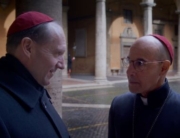There are few stories more emotionally rewarding than the redemption of a man who is lost. From A Winter’s Tale to A Christmas Carol, such narratives remind us that there is no point of no return, no such thing as a lost cause. A lovely addition to the canon, A Man Called Ove wields dark themes with a comic lightness that carries it through its more formulaic moments.
Ove (Rolf Lassgard) is a sort of Swedish Scrooge, except without money or power. Widowed, childless, and freshly fired, the 59-year-old has taken stock of his life and found it wanting. The only thing that gives his life meaning is his devotion to order. Every morning, he makes “his rounds”: patrolling the local community for such transgressions such as cars on designated “no driving” roads, unlatched gates, and improperly sorted recycling bins. One day, after his routine, he puts on a powder-blue suit, says goodbye to a photo of his wife, and hangs himself.
However, as another character later puts it, Ove is terrible at dying. The first of his many aborted attempts ends with a new neighbor backing into his mailbox—on a “no driving” road, no less—an offense that Ove cannot forgive. What follows is the first of many encounters in which a thwarted Ove runs about in his powder-blue suicide suit, chasing hooligans, and righting wrongs. Eventually, those hooligans get under his skin. Their struggles bringing out a warmth in him that he had thought was long gone.
The supporting cast seems incidental at first but soon provides an abundant supply of comedy and camaraderie. In particular, Parvenah (Bahar Pars), an Iranian immigrant raising her children in a strange country, becomes a woman of astonishing kindness and resilience, and the first to see Ove as more than an old crank. Others, such as a young gay man working at a falafel shop, disappear as soon as they’re introduced. But, by and large, the cast has great fun proving that it takes a village to raise Ove.
The extended flashbacks, detailing the events that made Ove who he is today, are somewhat less grounded. Though perhaps necessary, they lack the nuance of Ove’s modern-day antics, instead working in stark moral absolutes and depicting a paint-by-numbers love story. That said, there are a few fantastic visual moments. As young Ove is driven away from a church, he notices a bride and groom entering the front door. Carried out the back door, at the same time, is a coffin.
With the film’s constant rumination on death, there’s really only one way the movie can end. Ove’s renewed community takes the loss hard, but as the credits roll, one of the children he learns to love checks his gate, making sure it’s properly latched. It’s a predictable moment, but don’t be surprised if you find a tear rolling down your cheek.






Leave A Comment